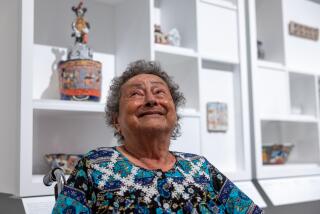Folk Discoveries : Latin Pieces From Renowned Texas Collection in Escondido
- Share via
If your exposure to Mexican folk art has been an occasional visit to tourist-oriented shops across the border, the Mathes Cultural Center in Escondido offers an opportunity to broaden your horizons.
Friday, the center opens an exhibit with the unwieldy, albeit descriptive, title of “Folk Art: Four Extraordinary Private Collections and Devotional Objects From the San Antonio Museum of Art.”
The exhibit includes works from the Bassler, McIver, Piarazzini and Morgan collections, which cover various cultures. The emphasis, however, is on Mexican folk art, featuring work from the impressive 8,000-piece collection of the San Antonio Museum of Art.
The museum’s folk art curator, Marion Oettinger, will lecture at 6:30 p.m. Thursday. Drawing on his 20 years as an anthropologist and curator, Oettinger will speak on “Arte del Pueblo: New Directions in Latin American Folk Art Collecting.”
Oettinger is as passionate a speaker as he is an explorer. Despite his many years of visiting remote villages throughout Latin America, he is still amazed by new discoveries.
“While people are familiar with the more popular forms of folk art, particularly commercial pieces, there is in fact an enormous amount of material that has not even been touched, primarily because people haven’t bothered to take tangents off the main roads--both mental and geographical,” he said.
“Collectors tend to focus on Oaxaca and Michoacan, but every place where there remains traditional culture, there’s something worthy of a museum’s attention.”
Oettinger’s own museum has quickly built a reputation as one of the country’s leading depositories of Latin American, and primarily Mexican, folk art. The base is the Nelson Rockefeller
Collection of Mexican Folk Art, which was assembled over a lifetime of travel by the late vice president.
When the Rockefeller family searched for a museum in which to house the collection, it sought out cities with significant Latino populations. Los Angeles and San Francisco were considered, but, eventually, 2,500 of the 3,000 pieces in the collection were given to the San Antonio museum. The Mexican Museum in San Francisco received the balance, but, according to Oettinger, his museum has “most of the significant pieces.”
Along with the gift, Oettinger was commissioned to write a book about the Rockefeller collection. It is scheduled for publication next spring.
Work from the San Antonio collection in the Mathes center show includes 9 calendas, which Oettinger described as “4- to 5-foot-tall processional pieces that represent saints important to a particular village in Oaxaca. They were made in the ‘50s and were lent to a religious order in town for celebrations. It’s very ephemeral stuff, and rare because they were made for the community and not for outsiders.”
That’s one of the main requisites for Oettinger’s definition of “folk art”: functionality, something used in a culture’s daily habits.
“What I’m interested in is stuff made for use by people--objects that are actually used.”
Those are distinguished, he said, from pieces made “as a response to what people in Santa Fe want to buy. They are attractive and decorative, but there’s a different inspiration.”
“Right now, we’re on the upswing of interest in terms of things Latin, which has to do, first of all, with the enormous amount of attention being paid to the 1992 anniversary discovery of the New World, which will involve most countries in Europe and every country in North America,” Oettinger said.
“Up to now, our orientation has been Eurocentric and Asian. People keep looking to the past for the future, but our future is in the New World. And the art of the New World is still exotic and largely unknown.
“I’ve worked in Mexico for 20 years, and every time I go down there I find the unexpected. It’s there if you’re willing to look for it. It’s not available in galleries. Once the makers refer to it as art, I’m not interested in it.”
Thursday’s lecture will be preceded by a reception at 6 p.m. The opening Friday is scheduled from 5-7 p.m., and the exhibit continues through Nov. 11.
Throughout the run of the exhibit, there will be a number of Saturday workshops for children. For more information, call the museum at 743-3322. The museum is at 247 S. Kalmia in Escondido.
More to Read
The biggest entertainment stories
Get our big stories about Hollywood, film, television, music, arts, culture and more right in your inbox as soon as they publish.
You may occasionally receive promotional content from the Los Angeles Times.










